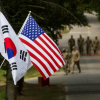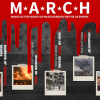
The Cold War order, despite all its risks, offered numerous advantages to both the United States and the Soviet Union. During the Cold War era, the world was split into two opposing camps, and the US and the USSR emerged as the natural leaders of their respective blocs. Their leadership was rarely questioned. Undeniably, the US benefited significantly from this arrangement, as being the leader of the Western bloc also meant assuming a dominant position in the global economy. Therefore, although the dynamics of the Cold War had already ended by the 1970s, the parties continued to wage an “imaginary war” as Fred Halliday put it (1). Archival documents clearly show that by the 1980s the Soviet Union was already in economic disarray and the White House was well aware of this. Ironically President Reagan’s policies in the 1980s were based entirely on demonizing the Soviets, and the Soviet Union was called “the evil empire”. The reason for the Reagan policies was not only the relentless hostility to communism or the narrow understanding of nationalism. The existence of the Soviet Union as “evil” gave American global leadership its natural legitimacy. Thanks to the Soviet threat, many countries voluntarily accepted American leadership and did not question it. “Natural leadership” has become one of the most important sources of power for the United States in managing the world order.
Keeping in mind the chaotic nature of the International System despite Francis Fukuyama’s enthusiastic optimism, thinkers like Samuel P. Huntington realized that it was difficult for the United States to maintain its global leadership without a common enemy (2). As if recreating the Cold War, Huntington theorized the “Clash of Civilizations” and attempted to re-divide the world into “West and the Rest”. The most probable new adversary would be Islam, with China and the Orthodox world also being potential global adversaries (3).
Despite Huntington’s pessimistic theory, the United States earned the new title of “superpower” following the Soviet Union’s withdrawal from the international political scene. The United States was the world’s only superpower at the top of the global order, and it no longer had a rival. Optimism pervaded American politics during the 1990s, with the most popular terms characterizing this period being globalization, humanitarian interventionism, and regional integration.
The US seemed unaware of the structural transformation of the global political economy as it enjoyed unrivaled and championed the idea of globalization. Western-origin transnational companies moved their production to China and other third world countries one by one, with the appeal of low cost. During the 1990s and 2000s, the governments of countries such as China, Indonesia and Vietnam, which were hungry for investment, foreign capital and technology transfer, made it a priority of their economic policies to attract Western companies to their countries with low exchange rates and other incentives. The US did not pay due attention to the great industrial exodus from its country to the Far East in the early years, and tried to cover its losses with its financial advantages. But de-manufacturing has led to unemployment, a decline in worker purchasing power, and other side effects. The loss of employment and income in the industry led to changes not only in the economy but also in American society and politics. The income gap between lower and upper classes fueled polarization and radicalization, particularly among the unemployed and the poor.
Another factor dueling the “idea of collapse” in American society was the unsuccessful invasions of Iraq and Afghanistan. The US lost trillions of dollars and prestige as a result of these two unnecessary but very costly operations thousands of kilometers away. The images of an “invincible America” and a “perfect democracy” were badly damaged in these wars.
Finally, the 2007 financial crisis hit America where it trusted most. By the 2010s, some countries such as China, India, Brazil, South Africa, Indonesia and Russia began to emerge as economic and political power centers in different geographies of the world. China in particular was no longer an underdeveloped country; The Chinese industry, which made a breakthrough by imitating Western technology, made the world economy dependent on it for many products in the 2010s. China, which has become the world’s largest economy after the US, has come to finance trillions of dollars of debt of the US with its savings of trillions of dollars. In the 2010s, “decadent literature” became the mainstream of political analysis in the US; In the words of Edward Luce, “it’s time to think” (4).
Western companies, leaving their home with capitalist motives, increased their global sales and made huge profits, but at the cost of millions out of work in Europe and America, and workers with reduced purchasing power at home. As the US economy exported more production-jobs to China and other countries to save money, people working those manufacturing jobs domestically lost work and could not find a new one. On the other hand, Western companies that settled in the Far East, especially in China, provided both wealth and technology transfer to the host countries. China’s GDP growth rate never fell below 6 percent between 1992 and 2018. China’s economy grew by double digits for most years. In the same period, the US economy has never been able to achieve 5 percent growth rate. Moreover, while America’s recovery from the 2007 financial crisis took a long time, China quickly overcame such crises. China’s GDP was only $1.2 trillion in 2000, while the US GDP was $10.2 trillion in the same year. By the year 2000, while the GDP of the US doubled in 20 years to 23 trillion, China’s GDP increased by about 15 times and reached $17.7 trillion in the same period.
In the early years, it was thought that companies investing in China from the West were temporary and could relocate their factories back to the West whenever they wanted. However, as these companies became more localized, technology transfer enabled the emergence of high-tech Chinese companies in the same sectors. In addition, transnational Western companies realized that they could not easily give up on China.
It has been both late and difficult for the American authorities to apprehend this transformation. The 2020 covid pandemic has been very instructive to understand how the process is against the US and how Washington has ended up dependenting on China-linked production, supply and transportation chains for many strategic products. If the manner had been preserved like this, China would not only surpass the US in economic size, but would additionally make the West depending on it in many areas from loans to high technology. Thus, the New Strategy, which includes taking measures against China in almost every field, was put into effect. The purpose of this campaign, which we can call “New Cold War”, is to prevent a possible hot war with China if possible, if not, to postpone it as much as possible.
The first part of the new strategy puts the US on its feet; The return of strategic industries that have fled to third world and China; become self-sufficient in the production, processing and distribution of strategic natural resources; In this context, removing China and other adversary states from the supply and logistics chain in the manufacture of semiconductors and similar products is the priority measure to be taken. For this purpose, Semiconductor investments started in Texas with Samsung, and in the north with Canada.
“The second pillar of the New Strategy is military preparations. Measures considered in this context include expanding alliance networks against China in the Asia-Pacific region and against Russia in Europe, increasing the defense budgets of allies to 5 percent of their GDP, and establishing permanent military bases around enemy countries. The most important part of the military measures is the rearmament of Japan and Germany and the formation of a significant military power.
Russia’s sudden and brutal attack on Ukraine in 2023 made it easier for Washington to do what needs to be done in the military field. Many states voluntarily accepted American military leadership and increased their defense budgets by billions of dollars. Finland and Sweden, which in the past did not want to join NATO, lined up in front of NATO to avoid the Russian threat, and Finland became the 31st member of NATO. NATO, which was dismissed as “brain dead” by Macron a few years ago, is now the fittest and largest defense alliance on the planet, thanks to Russian aggression.
The situation is no different in the Asia-Pacific region; Australia, New Zealand, Japan, South Korea, Taiwan, and the Philippines all want to come under the American nuclear umbrella to ward off possible Chinese attacks.
In short, similar to the Cold War years, the strategy’s essence is to economically, politically, and militarily besiege opponents. So is the American policy of containing China working? Honestly, it’s not easy, because the current balance of power is not only based on the two superpowers. The US is more powerful than any other state in the world, but it cannot manage the world order single-handedly. China is also strong and getting stronger day by day, but it is unable to establish a new global order. The old world order faded and the new could not be established. The current global distribution of power cannot be described as unipolar, bipolar, or multipolar, for the world is literally changing, the distribution of power is like a nebula, a cloud of gas and dust. We can say that the Cold War, which was delighted to end in 1991, is actually a great loss for the American leadership, and now a new but more difficult cold war begins.
NOTES:
(1) Halliday, Fred, The Making of the Second Cold War, (London: Verso, 1983).
(2) Fukuyama, Francis, The End of History and the Last Man, (London: Penguin Books Limited, 1993).
(3) Huntington, Samuel P., The Clash of Civilizations and the Remaking of World Order, (New York: Penguin, 1997).
(4) Luce, Edward, Time to Start Thinking, America in the Age of Descent, (New York: Grove Press, 2012).
Main Source: Modern Diplomacy
















